The Collective Definitions!
A reference sheet for certain terms/phrases that might come up during meeting discussions

Literary Theory
Practical Criticism
Cultural Theory
Formalism
Reader-Response
New Criticism
Psychoanalysis Criticism
Marxism Theory
Postmodernism
Post-Structuralism
Deconstruction
Feminist Criticism
viewpoint.
Queer Theory
Race Theory
people classed according to common racial, national, tribal, religious, linguistic, or cultural origin or background”)
Critical Race Theory (CRT)
Critical Disability Theory
Philosophical Theories
Stoicism
Nihilism
Absurdism
that personality selects is absolutely delightful to me.” -Oscar Wilde
Existentialism
“We’re all going to die, all of us, what a circus! That alone should make us love each other but it doesn’t. We are terrorized and flattened by trivialities, we are eaten up by nothing.”-Charles Bukowski
Empiricism
Rationalism
Emiricism’s mortal enemy. Relies on intellectual reasoning for the source of knowledge. Truth does not come from the senses but is naturally deductive.
“Rationalism doesn’t require ‘belief,’ only observation. The real, measurable world doesn’t care what you believe.” – Joe Haldeman
Confucianism
An Eastern philosophy that began around the 6th century by the philosopher Confucius. It was both religions and philosophy that focused on ethics, creating a strict social structure that prioritized family intellectual prowess for those in positions of higher hierarchical power.
“Before you embark on a journey of revenge, dig two graves.” – Confucius
“Only the wisest and stupidest of men never change.”― Confucius
Determinism
There is no free will, all events and experiences are the result of a chain reaction from past events that induce only one possible outcome of possibilities, which is the current present.
“Everything is determined, the beginning as well as the end, by forces over which we have no control. It is determined for the insect, as well as for the star. Human beings, vegetables, or cosmic dust, we all dance to a mysterious tune, intoned in the distance by an invisible piper.” – Albert Einstein
“The way out is the way through.” – L. Ron Hubbard
Objectivism
Developed by a Russian-American novelist, this philosophy has four core principles. There is an objective truth outside of oneself, absolute reason with no room for emotion or faith, individualism, and laissez-faire capitalism.
[Main character syndrome basically…sorta]
“My philosophy, in essence, is the concept of man as a heroic being, with his happiness as the moral purpose of his life, with productive achievement as his noblest activity, and reason as his only absolute.” – Ayn Rand
“There is a level of cowardice lower than that of the conformist: the fashionable non-conformist.” – Ayn Rand
Utilitarianism
Morality is determined by the action that causes the individual the most pleasure as opposed to his pain. Other’s happiness is directly connected to one’s happiness, and to produce the greatest amount of good for others is to do so for oneself.
“Nature has placed mankind under the government of two sovereign masters, pain and pleasure.” – Jeremy Bentham
“The end may justify the means as long as there is something that justifies the end.” – Leon Trotsky
Queer Terms
LGBTQ+ 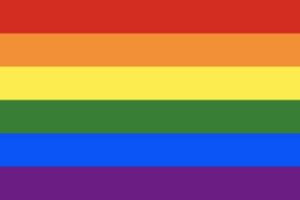 or
or  or
or 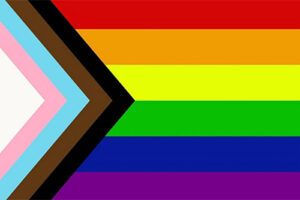 or
or 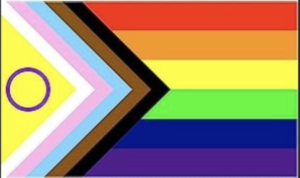
An acronym for Lesbian, Gay, Bisexual, Trans, Queer, Plus. A community of people who are unaligned with sexual or gender heteronorms.
Lesbian 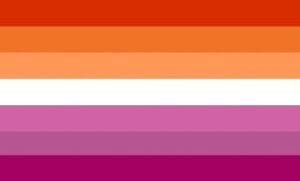
A woman who is sexually and romantically attracted only to people of the same gender. The term is not exclusive to cis-women and is used by gender-fluid, non-binary, or other gender-non-conforming people.
Sapphic 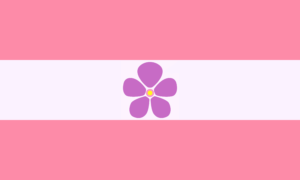
This term is a larger umbrella that encapsulates women, or women-aligned people, who are sexually and romantically attracted to women. It can include identities such as lesbian, bi, pan, queer, trans-femme, etc. Named after the Greek poet Sappho.
Lipstick Lesbian 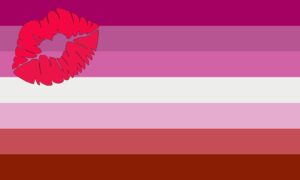
Fem-presenting Lesbians. (Term carries controversies as it implies Lesbians are by default masculine or butch. As well as being a phrase in the 80s for straight-passing women who had sex with other women for male pleasure. However, it has since been reclaimed by the Lesbian Community around the 1990s)
Butch  (2016)
(2016)  (2017)
(2017)
An identity within the community held by people whose gender expression aligns with cultural masculinity.
Labrys Lesbian Flag 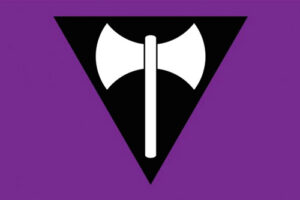
There have been many lesbian flags over the years, this flag was developed by Sean Cambell, a cis-gay man, in 1999. It’s not widely used today due to its symbology having historic roots in the Holocaust. (Homosexual men were branded with an upside down pink triangle as a mark of shame, and homosexual women were marked with a black upside down triangle.)
Gay 
Tends to be a blanket term for any person who is attracted to the same gender but historically has been mainly in referral to men who were attracted to other men.
Homosexual
Historically used to refer to anyone sexually attracted to the same sex. Though not offensive and still used in medical/scientific fields, it’s not common in everyday speak as it is considered largely outdated.
Drag Queen/King
A type of performance art where the “Queen” or “King” dresses as an exaggerated and over-the-top caricature of gender. Purposefully over dramatic and large. Extreme cross-dressing for entertainment or humor.
Monogamous
Having sexual and/or romantic relations with one person at a time.
Polyamory 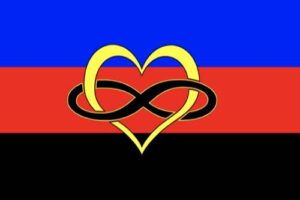
Being able to be romantically involved with multiple people and/or involved in multiple relationships with.
all parties’ consent.
Polysexual/Polyromantic 
Being either sexually and/or romantically attracted to multiple, but not all, genders.
Bisexual 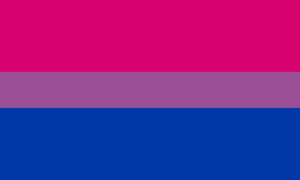
Shortened to Bi. It is a sexual and/or romantic attraction to two (or more) genders.
Pansexual 
Shortened to Pan. It is a romantic or sexual attraction to another regardless of gender. (Debate within the community surrounding the true differences between bi and pan as some believe that bisexuality has transphobic implications of being exclusive towards either end of the binary.)
Transgender 
Shorted to Trans, it is an umbrella term for people whose gender identity does not align with their sex, and so socially and/or medically transition from their assigned sex at birth to their gender identity. (AFAB- Assigned female at birth. AMAB- Assigned male at birth)
Trans Woman (MTF)
Someone who identifies and lives as a woman after being assigned male at birth. (MTF – Male to Female)
Trans Man (FTM)
Someone who identifies and lives as a man after being assigned female at birth. (FTM- Female to Male)
Transexual
The same as transgender, but considered outdated and offensive by many within the trans community.
Cisgender
A person who identifies with their sex assigned at birth.
Non-Binary 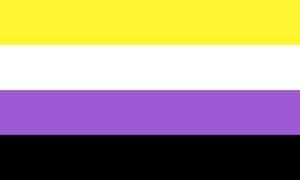
People whose gender identity does not align with the male-to-female binary.
Gender Queer  , Gender Fluid
, Gender Fluid 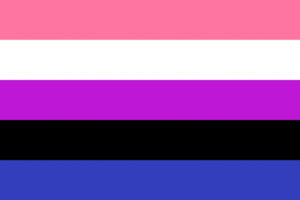 , Agender
, Agender 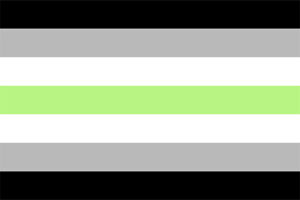
Some of the gender identities that fall under the non-binary umbrella. Genderqueer is a more political/radical identity for someone who falls outside of the male-to-female spectrum. Genderfluid is someone whose gender expression/identity is fluid and is never constant or fixed. Agender is someone who has no gender or remains gender-neutral.
Gender Identity
An internal sense of self.
Gender Dysphoria
A sense of discomfort is felt when someone’s gender expression does not align with their internal sense of gender.
Gender Binary
A cultural and social classification of behaviors, appearances, and roles for someone to abide by based on
their sex assigned at birth.
Gender Non-Conforming
Someone whose gender expression does not align with the gender binary.
Queer
A reclaimed slur by the community that serves as an umbrella term for the whole LBGTQ+, but mainly identities outside of the mainstream (i.e. gay men and lesbians). Queer Theory looks further in-depth into the concept of queerness and its relationship within a binary society. (Can be considered a more political
label)
Asexual 
Aromantic 
Demi Sexual 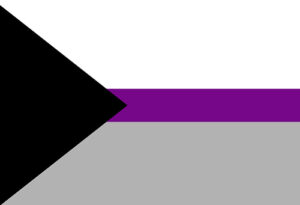
An identity under the asexual umbrella, describes someone who experiences no sexual attraction unless
they form a deep emotional bond with them.
Demi Romanic 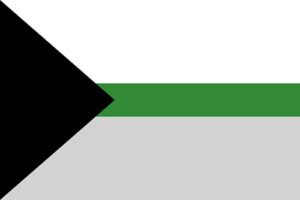
Someone who experiences no romantic attraction unless they form a deep emotional bond with someone.
Intersex 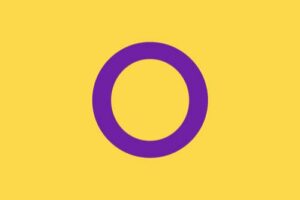
Someone whose sexual characteristics do not abide by the generally understood binary of male and female bodies. Historically they were referred to as “hermaphrodites” but this term is considered outdated and offensive. (There is debate on whether Intersex people are or should be included under the LGBTQ+ label. As some people within the community don’t identify as LGBTQ+ or Queer)
Ally 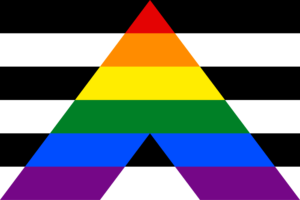
Someone who aligns with social binaries (cis, heterosexual, etc.) but still advocates for the rights of Queer people. This also refers to people within the LGBTQ+ community advocating for the rights of other identities outside of themselves.
TERFs
Trans Exclusionary Radical Feminist. Feminists who do not believe transwomen are women, and therefore do not advocate for their rights.
Heterosexual
Someone with sexual and/or romantic attraction to someone of the opposite gender.
Heteronormative
The view that heterosexuality is the “default” and normal sexual orientation.
Heterosexual Matrix
Coined by Judith Butler, it is the concept that everyone and everything is assumed to be straight until
proven otherwise
Assimilation
Conforming to social standards to be acceptable by the larger portion of society. An example of this would be gay marriage. (Some Queer theorists/activists believe assimilation is harmful to the Queer community as a whole, and instead, there should be a focus on dismantling the social binaries and systems. Not abiding by them.)
Intersectionality
The overlapping/crossovers of other social categorizations and how their interconnectivity affects individuals or groups. An example could be a feminist who does not consider race in her feminism, and advocates for only certain types of women while ignoring the prejudices and discrimination facing others
(See “White Feminism” under “Feminist Horror” below). Intersectionality would be feminism that focuses on all women’s rights, no matter their race, class, sexual orientation, gender expression/identity, etc.
Common Definitions for Horror
Genre
Media with similar content, style, format, and style. E.g.: Comedy, Action, Adventure, Horror, Drama, etc.
Sub-Genre
Subdivisions of a genre. Smaller/specific genres within a larger genre. E.g.: [See the chaos below] Urban fantasy, rom-com, cyberpunk, war and military action, etc.
Medium
How a piece of content is presented. E.g.: books, movies, comics, etc.
Horror
[Short answer – 🤷]
A genre of media with the express intent to scare, shock, and thrill the viewers. E.g.: Halloween (1978), It (Book and Movie- Stephen King), Old Gods of Appalachia (Podcast- DeepNerd Media), Fear and Hunger (Video Game- Miro Haverinen), Walten Files (YouTube series- Martin Walls), etc. [Debate surrounds
whether certain pieces of media can be considered horror based on differing factors such as ratings, genre, and style. If a thriller has horror elements does that make it a horror movie/book? Is Coraline a horror film? If you don’t find something scary does that make it not-horror? There are plenty of ‘horror’ movies out there that are objectively hilarious but are not categorized as comedies, does that take away from their intended goal? Hey look at that, Reader-Response has already shown its ugly head. Where is the line between Thriller and Horror? Comedy and Horror? Disturbing and Horror? If the intended purpose is to
scare, does that mean a horror with the express purpose to make consumers think isn’t horror? Some would say so, which leads us to-]
Post-Horror
Also referred to as Elevated Horror or Art-Horror, Post-Horror is a recent wave that is often associated with slow, minimalist, artistic films. They tend to focus on soaking viewers in dread and angst, taking traditional horror elements, and exploring their deeper psychological/existential themes. [There is some
controversy surrounding Post-Horror within the horror community as being a pretentious and unnecessary categorization. Art-Horror is arguably in itself a subgenre, but I decided to put it here considering this debate.]
Disturbing
[Ok, ok, I know I keep popping up but this one’s important considering that this is directly mentioned in our Rules. For the sake of this club, there is a difference between disturbing horror films (E.g.: Texas Chainsaw Massacre (1974), Midsommar (2019), and Tusk (2014). Body horror tends to fall under this category a lot) and Disturbing Films (also I know I keep saying “films” even though we aren’t solely confined to that in this club, but for the sake of bare-bones definition, it’s easier to explain these concepts in the space of film. Ok? Ok.) Now as I was saying-]
A genre of film that has grown in popularity in recent years in some internet spaces such as YouTube and Reddit due to the rise of “iceberg charts” (a visual categorization of a certain topic/theme that tends to be known by the wider public but has more to it then what is generally known. A “down the rabbit hole” type of thing). It is usually categorized by a lack of plot and with a focus on being as disgusting, offensive, hateful, and revolting as possible. In literature, you’ll find this sub-category referred to as Splatterpunk. E.g.: Anything below Tier 2 of this iceberg: Reddit – Disturbing Iceberg. Here’s a video breaking one of these
Icebergs down: The Disturbing Movie Iceberg Explained (GRAPHIC CONTENT).
[Finding a clear definition of the Disturbing genre can be difficult since disturbing elements are so common in horror that they often get conflated, and sometimes do in fact overlap. It boils down to semantics on whether Horror and Disturbing are truly that different of emotions, and that is a debate to be had. I mean while I was researching this I found an article listing “Midsommar” as a disturbing film. An occult horror film with disturbing elements, but not a Disturbing film. If you can play the film in theaters, it’s unlikely that it falls under this category. If you can’t find the film except on a sketchy gore website, then congrats, you found it.]
Content Warnings/Trigger Warnings (CW/TW)
A statement given about a piece of content regarding offensive or upsetting material it may possess. (Here’s an article for TW abbreviations if needed: Trigger Warnings 101 and here’s a resource for crowdsourced TWs for different types of content: Trigger Warning Database)
Mediums
[I know I don’t need to define mediums, I’m assuming most people who join this club already know 90% of pretty much everything that I’m talking about in this article. Even so, I’ll still add it, it’s good to include a breakdown of different types of media. Especially when we get further down and talk about specific terms that apply to specific mediums of horror. I promise we’ll get to the fun stuff after this.]
Print Mediums
Any type of written work, nowadays also includes a digital format as well as physical. This includes books,
magazines, blogs, comics, articles, etc.
Visual Art Mediums
Visible works consciously created through expression and skill. Includes: paintings, photography,
sculpture, drawing, woodwork, etc.
Performance Art Mediums
Art that is expressed as the process of taking an action, or accomplishing an action/task/function. Includes: theater, dance, music, happenings, etc.
[I could make this a whole other section, I mean look up Rhythm 0. Now that’s some horror for you.]
Audiovisual Mediums
Mediums utilize a combination of auditory and visual elements. Includes: film, video, television, etc.
Digital and Interactive Mediums
Works that require user interaction to function as intended, experienced through technology. Includes: video games, VR, ARGs [I’ll get to those later, but a lot of Internet Horror falls under this. Which I will also get to later]
Verbal Communication Mediums
Means of delivering or receiving information and data. Includes: Radio, podcasts, public speech, etc.
[Technically print, digital and interactive, and communication mediums can all be plopped under the term Mass Media (main means of communication), but with auditory storytelling being as accessible and popular as it is, it seems important to differentiate it from Digital and Print mediums. Non-verbal communication Mediums would just be everything else aside from auditory mediums.]
Mixed Mediums
Works that combine multiple mediums.
[A lot of the aforementioned mediums fall under this, Internet Horror and Digital Storytelling (using the Internet as an accessible means to communicate one’s story) in general tend to utilize mixed mediums a lot.]
Sub-Genres
[Now we get to the fun stuff. This is where it gets complicated because it could be argued there’s an uncountable amount of sub-genres. As horror evolves and the means of creative production become more accessible through the internet and communities, different sub-sub-genres are now popping up. If you take a shot every time you read the words sub-genre or sub-sub-genre, you’re not making it to the end of this thing. Let’s say Horror is a tree. The sub-genre branches and those branches can have leaves of different shapes and sizes, as well as their mini branches that sprout and have their leaves. Some branches are so close to each other that it’s hard to tell if they are their own thing or two entirely separate categories, some branches are rotten and some are just sprouting. It’s all interconnected as human creativity is hard to box and to stick too close to this tree metaphor would cause our tree to look less like a plant and more like a pulsating monstrosity made of multi-limbed twigs. That’s not even mentioning that there are different ways to perceive a tree. You can paint a tree, take a picture of it, close your eyes and listen to it, touch it, and all those open new opportunities to experience these “branches” in different ways. This is the case for all genres, but horror is especially complicated because humans are always afraid. Some love being scared enough that we planted the damn tree in the first place. Anyway, enough talk about trees. Unfortunately, I have boring things like school and work wasting my time when I could be breaking down the subtypes of Body Horror, so we’ll simply brush up on the basics here. I will be following this article as a guideline: The Ultimate Guide to Horror Subgenres. I know it says “film” but these can be applied to other mediums as well, they just tend to be called different things sometimes. I’ll also be providing some key phrases that are important when talking about each sub-genre.]
Psychological
Focuses on the mental, emotional, and psychological state of the human being. It is not jump scare-heavy and instead obtains its horror from the subdued and dreadful tone. Often storylines focus on an unreliable protagonist facing a state of psychological distress and madness, forcing the audience to confront the fragility of their psyche. [Art-Horror (see above) typically falls under this sub-genre. Hence the debate.] E.g.: Silence of the Lamb (Books and Movie- Thomas Harris), Psycho (Book and Movie- Robert Bloch) Get Out (2017), The Shining (book and movie- Stephen King), etc.
- Phobias- * “an exaggerated usually inexplicable and illogical fear of a particular object, class of objects, or situation”
- Madness- * “a state of severe mental illness —not used technically”
Mental Illness/Disorder-* “any of a broad range of medical conditions (such as major depression, schizophrenia, obsessive-compulsive disorder, or panic disorder) that are marked primarily by sufficient disorganization of personality, mind, or emotions to impair normal psychological functioning and cause marked distress or disability and that are typically associated with a disruption in normal thinking, feeling, mood, behavior, interpersonal interactions, or daily functioning” [Mental disorders are often misrepresented in older psychological horror, and even some newer ones honestly. Mental illness and psychological horror go hand in hand, and it’s hard to separate the two. As it has been used as a way to dehumanize those that have these disorders. Though an often introspective and fascinating sub-genre, it can be used to spread misinformation. Don’t be surprised to find Disability Theory popping out at you from all over the place in Horror] - Home Invasion- A sub-sub-genre about a foreign body invading one’s sanctity E.g.: The Strangers (2008)
- Survival- A sub-sub-genre about a looming threat throughout the piece threatening our protagonist as they struggle to survive E.g.: Hush (2016)
- Surrealism- Incorporating a lot of the experimental works, this subgenre has to do with themes of the subconscious. Being visceral and nightmarish in a literal sense in both visuals, audio, and plot. E.g.: Eraserhead (1977)
Slasher
One of the most famous sub-genre of horror, as it deals with the threat of outside bodies (both human and not) attacking a group of people and killing them off one by one. Tends to have a focus on body count and is less concerned with character development, with exceptions, and more so with the creativity of the deaths. It became a popular sub-genre aimed at teenagers about the 1980s or so. Sex/sexuality is almost always a key element of Slasher. E.g.: Halloween (1978), Friday the 13th (1980), Final Girls (Book- Riley Sager), Clown in a Cornfield (Book- Adam Cesare), Nightmare on Elm Street (1984), Slumber Party Massacre (1982), etc.
[Stereotypically considered “trash” films, as the acting and plot tend to be non-existence and its only focus is to get that kill count and the sexy dead lady shot. Recently though there’s been almost a counter-movement to revive the slasher genre by retrospectively twisting the formula. Reflecting social shifts in attitude about sexuality and gender. X (2022) is the perfect example of this.]
- Final Girl- A trope popularized by the film Black Christmas (1974) where the cast of victims (usually all women) is outlived by one “final girl.” Typically Final Girls are virgins, serving as a virtuous force against a violent opposition. [Ironically Black Christmas, though defining this trope, defied it. By killing the virgin first and having the woman who openly admitted to wanting/getting an abortion be the survivor.]
- Giallo- A specifically sub-sub horror film genre that originated in Italy, named after the novel series Il Giallo Mondadori (Anthology Book Series- Multiple Authors Contributed) that was published with a distinctive yellow color (Giallo translates to Yellow). Who did it type films with everyday protagonists playing amateur detectives as they attempt to unravel a string of gory and artistic murders. Argento is a famous Giallo director who is notable for his “Hand of Death”. E.g.: The Bird with the Crystal Plumage (1970), Your Vice is a Locked Door and Only I Have the Key (1970), Four Flies on Gray Velvet (1971), etc.
- Hand of Death- Not exclusive to horror but popular in Giallo, it is a film trope where viewers can only see the hand or weapon as it kills a character on screen. Hiding the identity of the killer, though not necessarily, they’re usually shrouded in a black glove. These black gloves can be traced back to Argento films, as the director always featured in his movies as the Hand of Death. [If you’re a cinephile and love Giallo and would like to delve down the rabbit hole about Argento, here’s a link to a book written about him by a personal friend of his: Profondo Argento: The Man, The Myths And The Magic. An interview with said author, Alan Jones, can be found in episode 3 of the podcast The Evolution of Horror]
- Backwoods- A sub-sub-genre of slasher defined by its setting within forests, woodlands, or any rural location. [City folk makin’ their way out in the country and gettin’ themselves hacked up by a bunch of hicks.] E.g.: Texas Chainsaw Massacre (1974)
Gore and Disturbing
[Wait? Didn’t I have an entire section arguing that Disturbing and Horror were different genres? Yes. Yes, I did, but I also said that there was a crossover and that there are plenty of disturbing Horror mediums. There’s a difference between Saw (Movie Franchise- 2004) and Slaughter Vomit Dolls (2006) or Hell Follows with Us (Book- Andrew Joseph White) and Playground (Book- Aaron Beauregard)]
A sub-genre of horror that deals with the extremes of gore and other disturbing elements. There is a bit of distinction between gore and disturbing, as gore relies primarily on bloody shock value while disturbing has that but with a touch more emphasis on the psychological elements as well.
- Torture (aka Torture Porn)- A sub-sub-genre defined by its specific brand of sadism as it focuses heavily on the torture, mutilation, and suffering of characters.
- Body Horror- Focuses on the transmutation and distortion of the physical human body. [One of my favorite sub-genres, which is weird cause I hate all of the other sub-sub-genre stuff under this section, and they do tend to overlap sometimes. Some of the best monster designs utilize body horror as it takes the familiar and keeps it recognizable enough to be upsetting when you see just how far the mind can contemplate the transfiguration of the physical form while still keeping it recognizable as a Person. Silent Hill has a lot of good examples of body horror monsters, also basically anything the manga artist, Junji Ito touches.] E.g.: Silent Hills (Video Game-Keiichiro Toyama), Body Shocks (Anthology- Multiple Authors Contributed), Fear and Hunger (Video Game- Miro Haverinen), Hell Followed with Us (Book- Andrew Joseph White), etc.
- Splatter (Gore Films) – Similar to Torture Porn, Splatter tends to focus on the torture and mutilation of the human body, though there’s a bit more social commentary attached to them. E.g.: Final Destination (Franchise- 2000), Cannibal Holocaust (1980), Terrifier 2 (2022).
- Splatterpunk- a movement in horror fiction that began in the 1980s that was characterized as horror without limits. Social taboos and respectability are targeted and counterattacked to the extreme. Though not limited to books, Splatterpunk tends to remain a genre primarily literary. E.g.: Son of the Slob (Book- Aaron Bearegard), Splatterpunk: Extreme Horror (Book- Paul M. Sammon), Playground (Book- Aaron Bearegard) [We will not be touching Splatterpunk as reading material for the club, but if you wish to explore this particular rabbit hole, have at it. If you want to read more about it, here’s an article I found: Splatterpunk. This website seems to have been created in the mid-90s and I haven’t combed through the whole page, from what I’ve seen there are just transcribed interviews and blogs. Still, explore at your discretion.]
- Cannibal- Cannibalism is the act of a species eating its kind. Cannibal Horror is taking this and using it for shock value. E.g.: Hannibal (TV Show- 2013), Raw (2017), A Certain Hunger (Book- Chelsea G. Summers), Tender is the Flesh (Book- Agustina Bazterrica), Exquisite Corpse (Book- Poppy Z. Brite)
- Extreme Horror (aka Exploitation Horror)- The most extreme and plotless of the sub-genres above. Extreme Horror tends to be banned in many countries due to its explicit and volatile nature. [This is the line from where Horror becomes Disturbing. The pipeline leading from A Siberian Film to Snuff. If you do not know what Snuff is, I won’t be defining it here, but it won’t take much to guess.]
[I hope you appreciate the effort I put into this thing. I had to research “SplatterPunk” for almost two hours, and I would die happy if I never had to read another word about it again. I’m sure you understand we won’t be touching a lot of this in a school club and why we had to make No Disturbing a rule. With that being said Body Horror and Cannibal is still absolutely on the table, as I said before Body Horror is one of my favorites and Hannibal is as cannibal as you can get. Plus cannibal horror has been making a resurgence in mainstream media. You can’t go five seconds on Horror BookTok without running into someone shoving Tender is the Flesh down your throat (pun intended). But considering the disturbing nature they can have, we’ll have to be a lot more picky with them than other sub-genres.]
Monster
A focuses on an oppositional supernatural force as a source of conflict, these supernatural forces can range from humanoid to completely alien [ha].
- Zombies- Reanimated corpses that in some iterations like to commit cannibalism upon the living. Zombies have been present in many cultures and folklore around the world, though they might have some slight variations. E.g.: Night of the Living Dead (1968), Shaun of the Dead (2004), The Walking Dead (TV Show- 2010), etc
- Virus- An unknown and uncontrollable disease affects the population, making everyone around you a risk to your health and well-being, regardless of their intent. E.g.: The Crazies (2010), 28 Days Later (2002), I am Legend (Book and Movie, Richard Matheson) [Tends to cross over with Zombies]
- Vampires- A classical monster that was popularized in literature by 1819 in John William Polidori’s The Vampyre (Short Story- John Polidori). Though its origins can be traced back further than that within European folklore. Modern depictions vary but mainly are aligned with Bram Stoker’s Dracula in that they are undead bloodsuckers who use their supernatural allure to tempt their prey into their clutches. E.g.: Carmilla (Book- Sheridan Le Fanu), Dracula (Book- Bram Stoker), Twilight (2008) [Mormon Horror counts], Midnight Mass (TV Show- 2021)
- Werewolf- With themes of man and beast, and where that line is drawn, the werewolf is a shape-shifting creature that is cursed to change from man to monster at the whims of the night. There are plenty of changeling monsters, but werewolves have always stayed present in mainstream consciousness. [If you want to read about the history of werewolves here’s a cool article I found: The Ancient Greek Origins of Werewolves – GreekReporter]
- Myth- Historically orally transmitted explanations for the origins of people or natural phenomena, typically sacred.
- Folklore- Similar to Myth but more grounded to the common people, folklore tends to hold many customs and rituals of the cultures they originate from. [Because of this, sometimes culturally significant stories can be stolen and repurposed by people outside of a culture, diminishing and disrespecting the original practice. If you’re a horror creator, it’s always a good idea to research the origin of your monsters. I love researching Folklore and if you’d like to learn more about this topic there are a plethora of books on the subject and I’d recommend checking out the podcast Lore by Aaron Manhnke. Southern Appalachian Folklore is my personal favorite, but that’s just me.] Plenty of horror monsters are either retelling or directly inspired by these myths and lore. E.g.: The Only Good Indians (Book- Stephen Graham Jones), The Ritual (Movie and Book- Adam Nevill), Nothing but Blacken Teeth (Novella- Cassandra Khaw), etc.
- Kaijū- A term popularized from old Japanese monster movies where the monster is incredibly large and poses as an unstoppable force that seeks to harm humanity. There are other large creature movies as well, but kaijūs are the most well-known in mainstream media. E.g.: Godzilla (Franchise- 1954), Attack on Titan (Manga and Anime- Hajime Isayama), King Kong (Franchise- 1933), etc.
- Creature Feature- Another term for monster movies
- Aliens- An unknown creature whose origin is typically space. Aliens tend to touch on the fears of the unknown as they don’t follow the laws of Earth’s creatures or our understanding of biology. These themes are explored more deeply within Cosmic Horror. E.g.: Alien (1986), Nope (2022), Independence Day (1996)
- Sci-fi Horror- A subgenre that can fall under the Monster Horror category but is not required to. As it is a hybrid between Science Fiction and Horror. E.g.: Iron Lung (Videogame- David Szymanski), Frankenstein (Book- Mary Shelly), Aliens (1986), Deviser (Podcast- Harlan Guthrie)
Paranormal
Similar to Monster horror, Paranormal also deals with supernatural opposition in a very direct way. It focuses on possible phenomena that could be theoretically possible but have yet to be proven by the scientific community. There is a strong belief in the paranormal by many people, usually, there is a spiritual element to it.
- Ghosts/Spirits- Ghosts are the essence of a human consciousness remaining in the physical plane instead of moving on to a hypothetical afterlife. Ghost depictions and representations vary throughout years and cultures, they can be good or bad depending. Spirits are similar to this, except they are not and never were human. However, there are always exceptions based on interpretation. E.g.: Poltergeist (1982), A Head Full of Ghosts (Book- Paul Trembly), The Conjuring (2013), House of Leaves (Book- Mark Z. Danielewski)
- Haunted House- Similar to Backwoods, this is a sub-subgenre that is based solely on the setting. Usually, haunted houses that are middle to upper-class, very large, and imposing with architecture reminiscent of the Gothic. E.g.: Haunting of Bly Manor (TV Show- 2020), Haunting of Hill House (TV Show and Book, 1959, Shirley Jackson), Babdook (2014)
- Possession- Taking from the spiritual factor of the paranormal, this sub-sub-genre tends to deal with the invasion of the body and soul by an outside entity. However, humans are not the only thing subject to possession. More occult movies under this tend to have the malevolent invader be of a demonic origin. E.g.: The Exorcist (Movie and Book- 1973, William Peter Blatty), Christine (Movie and Book- Stephen King), Rosemary’s Baby (Movie and Book- Ira Levin)
- Devil-In Christian theology a devil is a fallen angel from heaven that is caught within the realm of hell. Demon is the plural of that. Even in not explicitly Christian horror [yes, that is a thing] demons are a common element in possession and paranormal horror as they serve as the embodiment of the ultimate evil. Sometimes their unnamed demons, but other times they take from Christian theology and create interpretations of Satan or the lords of hell. E.g.: The Omen (1976), My Best Friend’s Exorcist (Book- Grady Hendrix), Hereditary (2018), etc. [If you’re interested in demonology, here’s a cool website to browse through, it gives a list of demons. Though it does have creepy uncanny pictures so if those bother you I’d skip it: Welcome – Demon Facts]
- Witches- * “a person (especially a woman) who is credited with having usually malignant supernatural powers.” Witches were often persecuted historically by Christians and were the origins and multiple hysterias throughout the years where religion was used to persecute women who stepped outside of gender norms or had religious/spiritual practices that deviated from theirs. This caricature of witches bled into modern media and popular culture as a woman who hates children and possesses magical powers. E.g.: The Witches (Book and Movie- Ronald Dahl), The VVitch (2016), The Year of the Witching (Book- Alexis Henderson), The Blair Witch Project (1999) [For the history of real witches throughout history, here’s an article from the History Channel: Witches: Real Origins, Hunts & Trials | HISTORY]
- Paganism- * “spiritual beliefs and practices other than those of Judaism, Islam, or especially Christianity” [This is a rabbit hole even I don’t have time to delve into. If you want more info, here’s an article: Paganism | Definition, Beliefs, Origin, & Christianity | Britannica. I know that there’s controversy regarding modern pagans, Wiccans, and Native American spiritual practices. I’m not sure of the specifics, could be a fun research rabbit hole though if it piques your interest.]
Comedy Horror
Similar to Sci-Fi Horror, Comedy Horror takes elements of both genres and usually takes a comedic spin on what is otherwise an uncomfortable topic. E.g.: Shaun of the Dead (2004), American Psycho (Movie and Book- Bret Easton Ellis), and any Jordan Peele movie. [A lot of philosophical theories pop up in horror as well as comedy. Especially Absurdism and Surrealism.]
- Parody- An over-the-top ridicule or mockery of another property/person E.g.: Scary Movies (2000), What We Do in the Shadows (2014), etc.
- Satire- mocking of politics or social constructs
- Dark Comedy (aka Gallow Humor, Black Humor, Black Comedy)- a humorous spin on dark or taboo matters, all of Comedy Horror [if done right] falls under this umbrella.
- Dramatic Irony- Using drama to convey a contradicting situation or statement that reveals the truth of a situation than what was previously assumed to be factual.
Eldritch Horror
This sub-genre is dedicated to the fear of the unknown. It contemplates the limits of human comprehension and pushes it beyond what a mind can hold. Themes of eternity and infinity are common and so there tends to be a crossover with space elements. Also referred to as Lovecraftian and Cosmic horror.
[Yes, this is one of my all-time favorites. From what I can tell, mainstream media still tends to refer to this as Lovecraftian horror, but due to its deeply problematic roots, there’s been a growing movement to refer to it as Eldritch horror. I suppose people do call it cosmic, and if you do people will know what you mean, but from what I’ve seen Eldritch seems to be more popular.]
E.g.: The King in Yellow (Anthology- Robert W. Chambers), Malevolent (Podcast- Harlan Guthrie), The Magnus Archives (Podcast- Rusty Quill), Lovecraft County (TV Show- 2020), Old Gods of Appalachia (Podcast- DeepNerd Media)
- Eldritch- * “strange or unnatural especially in a way that inspires fear”
- H.P. Lovecraft- The founder and namesake of Eldritch Horror, he was an author who wrote in the early 1920s and died in March of 1937. Creator of famous entities such as Cuthlu and the Necronomicon. [Incredibly important note on Lovecraft, he was racist. Like incredibly racists. He was racist for his time and he was a white man born in the 1870s. Lovecraft named his cat after a slur, both his parents were institutionalized to a mental ward, and he grew up to be an extreme hermit. Overall an interesting character and though reading his work won’t support him in any way, you can’t separate him from his work. His writings were as racist as he was, but if you want to learn about Eldritch horror it’s always good to know the history of things, and he is intrinsically tied to this sub-genre. If you want to learn more about him and his life, here’s an article: H.P. Lovecraft | Biography, Books, & Facts | Britannica]
[Eldritch horror deals a lot with nihilism and existentialism, focusing on the emotions provoked by the undefinable. It tries to hold that feeling in its hand that arises when gazing at a night sky unblemished with light and realizing that it’s looking back down and seeing nothing at all because to its eye the entirety of the galaxy is a speck of dust having birthed and died in the time it takes for its heart to beat. This next link is to a pdf that I got from my Gothic class and it’s the literary equivalent of smashing your head into a wall, but I will begrudgingly admit that deeper discussions on these topics are aided by having read it. It attempts to categorize and explain the why of certain concepts and feelings experienced by humans. It’s only one’s philosopher’s take on the subject, but it can serve as a jumping-off point for deeper discussion on the subject. Do I recommend it? No, it’s the worst thing I’ve ever read. Here you go: Burke Edmund-Of the Sublime and Beautiful.pdf. Here are some short YouTube videos discussing it: Burke on: The Sublime – YouTube & Edmund Burke on the Sublime – YouTube. And here’s a random Reddit thread I found discussing writing Cosmic horror that I thought was cool: A Short Guide to Writing Eldritch Horror_Reddit]
Gothic Horror
The grandparent of modern horror in the literary space, began to arise as an opposition to the Roman and Classical and named after the Goths which were a Teutonic race from Scandinavia. During their war with the Romans and Greeks, they would leave their legacy by destroying their architecture, hence the Gothic being identified by the decayed and ruined. Modern Gothic tends to be defined by the aesthetic while in the beginning it served more as a political and social tool to reinforce fears surrounding the defiance of gender/social expectation. Virtuous was awarded and vice was punished, spaces were gendered. To remove the woman from the domestic ways to threaten her life. E.g.: Dracula (Book- Bram Stoker), Mysteries of Udolpho (Book- Mathew Lewis), Jane Eyre (Book- Charlotte Brontë), Carmilla (Book- Joseph Sheridan Le Fanu), Frankenstein (Book- Mary Shelly)
- The Female Gothic- Popularized by Ann Radcliffe this was the beginning of Feminist Gothic (perhaps even some of the earliest literary examples of Feminist Horror) as it had a focus on sexual female liberation. Though it still reinforces the gendered spaces of the time. E.g.: The Italian (Book- Ann Radcliffe)
- The Male Gothic- Engaged with a male conflict with patriarchal authority, themes of Odepital complexes, suppression, and execution. Queer themes began to become a notable feature as many Male Gothic authors tended to be discreetly homosexual to some degree. E.g.: Castle of Otranto (Book- Horace Walpole), Picture of Dorian Gray (Book- Oscar Wilde), Dracula (Book- Bram Stoker)
- Here are some articles taken from my old Gothic Lit class if you want to read further into this [They are all incredibly boring, so have fun]:
- Romantic vs Gothic: The Gothic versus Romantic .pdf
- Elements of Gothic:Gothic response.pdf
- Aesthetics of Gothic: gothic aesthetic.pdf
Found Footage
A filming technique of amateur footage being recorded from a low-quality camera held by a character within the story, the technique can be traced back to the 1950s but it was around the mid to late 2000s where it spawned a new subgenre of horror. One of the most famous of which is The Blair Witch Project (1999). Other examples of Found Footage techniques can be found in Peeping Tom (1960) and The Walten Files (YouTube series- Martin Walls). Though neither falls under the category of Found Footage Horror, the whole film must be recorded in this way. This is an accessible and cheap form of horror that has opened the door for new horror creators to start their portfolio. E.g.: Hell House LLC (2016), Paranormal Activity (2008), Cannibal Holocaust (1980), Unfriended (2015), The Backrooms (YouTube Series- Kane Pixels), No Through Road (YouTube Short Film-indrancole3)
Folk Horror
Coined in 1971 by Rod Cooper in a review of the film The Blood on Satan’s Claw, this sub-genre is setting-based and typically resides in rural woodland areas. In American Folk Horror this usually means more southern settings and cultural implications are held throughout the story. This is an atmospheric genre, similar to gothic, and though there are similar themes in it (occult, isolation, unknown) it’s more about the setting combined with the rural culture. E.g.: The Wikerman (1974), The Whisper Man (Book- Alex North), Her Body and Other Parties (Book- Carmen Maria Machado), Midsommar (2019)
Post-Apocalyptic
A survival sub-genre, focusing on the fear of living through a traumatic event that wiped out a good portion of humanity, enough where modern society has crumbled. The world’s landscape has changed and depending on the apocalypse the threat is still looming, and if not, then the other fellow men will do anything to survive. Including killing our protagonists. E.g.: Birdbox (Book and Movie-Josh Malerman), Suffer the Children (Book- Craig DiLouie), I am Legend (Book and Movie- Richard Matheson), etc. Apocalypses can range from mundane to supernatural, some examples include:
- Plagues- The Stand (Book- Stephen King)
- Societal Collapse- Bird Box (Book and Movie- Josh Malerman)
- Robot Uprising- I Have No Mouth, and I Must Scream (Book- Harlan Ellison)
- Nuclear Holocaust- Fallout (Video game- Interplay Entertainment)
- Monsters/Aliens- Cloverfield (2008)
Internet Horror
A large umbrella term for a rising sub-genre that has grown alongside the influence of the internet. Like Found Footage, it is an incredibly accessible place for horror creators to put their work out there. It is any horror property that is presented on or utilizes the internet as a medium.
- Analog Horror- An aesthetic genre that utilizes outdated technology to tell its story. Using technological glitches to distort the quality of audio and visuals. A very popular sub-genre on YouTube. E.g.: Walten Files (YouTube series- Martin Walls), Greylock (Youtube series- Rob Gavagan), Mandela Catalog (YouTube series- Alex Kister), Hi I’m Mary Mary (YouTube series- hiimmarymary)
- Unfiction- A subcategory of fiction that treats itself like nonfiction within a fictional world. Often these can be found in ARGs. It’s a story that makes a point to act as if it’s not. E.g.: MyHouse.Wad (Custom Doom II Map-Veddge), Lacey’s Wardrobe (YouTube series- ghosttundra), Rapid Eyes (YouTube series- Rapid_Eyes) [This guy only has 21k subs. So if the idea of a man being psychologically tormented by a game that won’t get off his computer sounds good to you, I say check it out. He has a soothing voice. Even if the pacing is slow, it’s a very comfortable vibe.]
- ARGs (Alternate Reality Game)- A multimedia sub-genre that utilizes blogs, videos, web design, and more to build an internet interface for a reality that does not exist. Using the internet as a way to create another world and immerse readers not with a typical story with a protagonist, but rather by having them interact actively with a setting already made. They can be treated as a puzzle as to progress the story, users usually need to have a full understanding of the web interface to find clues hidden in image files, HTML , and cryptography to figure out the next URL to plug in. Here’s an article discussing the topic further: What Is An ARG? The Layman’s Guide to ARGs – Cultured Vultures. E.g.: Petscop (YouTube Series- Petscop), Hypnagogic Archives (Website & YouTube series- Nicolas Sequeria), Welcome Home (Website- Clown Illustration), Marble Hornets (YouTube series- MarbelHornets), The Sun Vanished (Twitter Account-@didyoueverheal & @DaveyPeppers) [This iceberg goes deep, I’ve never played much myself except Welcome Home. I found this iceberg on Reddit though, so if this sounds interesting to you maybe check it out: Reddit -ARG Iceberg]
- Mascot Horror- A subgenre of horror that has bled off the internet but is mostly aimed towards children. Beginning with Five Nights At Freddy’s in 2014, it started a trend of colorful antagonists that played off of retro childhood nostalgia. It’s mostly a sub-genre found in video games but considering its appeal to a younger audience, many Let’s Players tend to gravitate towards it, making it popular with YouTube analysis and theory content. This sub-genre is prominent in certain spaces on YouTube. E.g.: Five Nights at Freddy’s (Videogame- Scott Cawthon), Bendy and the Ink Machine (Videogame- TheMeatly Games), Poppy Playtime (Videogame- MOB Games), etc.
- Lets Players- Content creators who make videos/streams surrounding them playing video games for entertainment purposes.
- CreepyPasta- A horror-related legend that is shared across the internet. A spin of the phrase “CopyPasta” meaning a block of text that has been posted multiple times across the internet. Can range from video, blogs, forum posts, art, and more. [Time for me to pop in again, CreepyPastas first began around the 1990s and is a sub-genre of Internet horror that’s not so much defined by themes but rather how it’s communicated. Similar to folklore. CreepyPasta has a reputation for being terrible, as anyone can write one, and due to the non-thematic criteria of this sub-genre, it therefore has its sub-genres. Such as Haunted Videogame Cartridge CreepyPasta, and yes, there are a lot of those. Occasionally though CreepyPastas will get so popular that they will leave the internet and be published in more “respectable” mediums. Such as Penpal by Dathan Auerbach which was turned into a book or Channel Zero a TV show on Shudder inspired by the CreepyPasta Candle Cove by Kris Straub-same guy who made Local 58. CreepyPasta found its peak in the early 2000s and started dying a little after the mid-2010s. There’s no definitive reason as to why, possibly because most “CreepyPasta kids” outgrew it. Or it could have been because it inspired a real-life attempted murder which probably didn’t help its reputation. Here’s the Wiki on that incident: Slender Man Stabbing – Wikipedia. CreepyPasta will always exist in one form or another on the internet, a recent example would be The Backrooms (wiki here: Backrooms Wiki | Fandom). If you want to dive down this rabbit hole of CreepyPasta then here’s a YouTube iceberg video about it: The Ultimate Creepypasta Iceberg Explained.] E.g.: Ted the Caver (Blog post- Ted Hedgemann), The Slenderman (Story & Monster design- Eric Knudsen), Sirenhead (Monster design- Trevor Henderson), Russian Sleep Experiment (Short Story- OrangeSoda), etc.
Occult Horror
Horror that tends to derive from religious and mystical beliefs taken to a stark dark extreme. Typically paganistic and satanic religions are the horror figure, but not exclusively. Nearly always has overlap with supernatural.
[I always thought as Occult Horror to be the opposite of Religious Horror. Where Occult Horror fears the Church, Religious Horror fears the believes itself. As strange as it sounds I’d argue that Mandela Catalog (Alex Keister) is a perfect example of religious horror, as it is most terrifying to those that hold Christian believes. Considering in canon Christianity was tricked into worshiping the Devil/Devil figure. Whereas take The VVitch (2015), there are demons but mostly the main figure of fear is how the family’s faith was contorted and used to justify the abuse they inflicted on Thomasin. The line between the two can be blurred and defining that line can be a fascinating conversation for another day. But basically Occult boils down to demons, witches, devils, magic, and worship of evil as opposed to good.] E.g.: The Children of Red Peak (Book – Craig Dilouie), The Wicker Man (1974), Rosemary’s Baby (1968), Slewfoot: A Tale of Bewitchery (Book – Brom), The Exorcist (Book and Movie – William Peter Blatty)
- Paganism – *”spiritual beliefs and practices other than those of Judaism, Islam, or especially Christianity: such as the spiritual beliefs and practices of ancient polytheistic religions & the beliefs and practices of contemporary religions or spiritual movements based on ancient paganism”
- Wicca – *”a religion influenced by pre-Christian beliefs and practices of western Europe that affirms the existence of supernatural power (such as magic) and of both male and female deities who inhere in nature and that emphasizes ritual observance of seasonal and life cycles”
- Demons – Malevolent supernatural beings, often associated with religious beliefs.
- Demonology – Study of demons
- Midsummer – A Nordic summer solstice festival.
- Cult – *”a religion regarded as unorthodox or spurious”
- Church – *” the clergy or officialdom of a religious body”
Feminist Horror
A type of horror with the express intent to explore feminist theories and themes. Though other horror properties can have feminist elements and be dissected through a Gender Critical lens, Feminist Horror takes a niche and deliberate approach to deconstructing gender relations. Focuses mainly on the female experience and tends to have women protagonists or a mostly female cast. Women’s issues are a prominent theme. E.g.: Pretty Girls (Book- Karen Slaughter), The VVitch (2015), Raw (2016)
- Patriarchy- A hierarchical society that determines power based on sex, with males holding more power than females
- Sexism- The concept that one’s sex determines their value and that the female sex is less than males
- Misogyny- Prejudice of women
- Misandry- Prejudice of men
- Internalized Sexism- When women’s inferiority becomes part of a woman’s world view
- Misogynoir- racist misogyny faced by Black Women specifically
- SWERF (Sex Worker Exclusionary Radical Feminist)- Feminist who believed that Sex Workers are counterproductive to the Feminist movement
- Women of color- Another way of saying POC Women
- Sex Postive- A more open and positive attitude towards sexual exploration
- Privilege- An social, political, or economic advantage over another
- White Feminist- Feminism that has a lack of intersectionality and focuses on the plights and struggles of White Women alone.
Race-based Horror
Though not exactly a sub-genre in itself, it is a growing trend/theme in horror works that take a historically primarily white genre and deconstruct the biases that main stream Horror perpetuated. These horror mediums fall under other sub-genres but have central themes regarding race and the systematic compliance of white people to racism. [Here’s an interesting excerpt from an article I found about the topic: “When The Exorcist dropped in 1976, he [James Baldwin] wrote a piece in response titled ‘The Devil Finds Work.’ Wherein Baldwin implies that because white audiences rarely experience genuine fear in their daily lives, horror thrives as a film genre. Going to see fear in a controlled environment is fun in that way. There’s a distance, a resolution. Unlike the daily list of recurring fears that are normalized in the Black experience. So, when Black creatives explore horror (the fearful), what they really do is transmute terror (the traumatic) into something digestible for those who do not experience it.” Here’s the link: ‘Nope’ and the Legacy of Race-Based Horror – Black Nerd Problems] Deconstructing and exposing oppression and brutality based on race. Race Theory and CRT are prominent in these types of horror. Jordan Peele’s films are the most popular examples of this, his work includes, Get Out (2017), Us (2019), and Nope (2022). Other E.g.: Candyman (1992 & 2021), His House (2020), The Ballad of Black Tom (Book- Victor Lavall), The Black Guy Dies First: Black Horror Cinema from Fodder to Oscar (Nonfiction Book- Robin R. Means Coleman & Mark H. Harris), etc.
- There are a lot of terms for this topic, and some overlap with others, so I’m just going to link a website that gives an overview of a bunch of terminologies that can be used in these discussions: Glossary | Racial Equity Tools
Queer Horror
Considering the overt anti-LGBTQ nature of a lot of horror [Stephen King killing off a gay man in the opening of It], some consider Queer Horror to be explicitly queer characters in a queer space. However, there are plenty of subtextual queer themes in lots of horror [though played off as a joke, one of the kids, Richie, displays romantic advancements to his friend Eddie in It. One of their first conversations involves them kissing.] as it is a very othered genre. Many authors of the Gothic were queer in some way, and though not explicitly gay, Dracula has themes of persecution. Because of this, it is hard to pin down an exact definition of Queer Horror. That’s a lot of what this club is about, discussing these themes and ideas and exploring the horrifically queer.
- See Above for terms
Citation Links
Literary Theory: Understanding 15 Types of Literary Criticism – 2024 – MasterClass
Feminist Theory: Definition and Discussion (thoughtco.com)
Critical race theory (CRT) | Definition, Principles, & Facts | Britannica
*Merriam-Webster: America’s Most Trusted Dictionary
Critical Disability Theory (Stanford Encyclopedia of Philosophy)
Reddit – https://i.redd.it/agyqoaeyb2s61.jpg
Trigger Warnings 101: a beginner’s guide | by @Untonuggan | Medium
Trigger Warning Database for Movies, TV, Books and more. (doesthedogdie.com)
Giallo Films Explained — Italian Horror, Argento, Bava & Beyond (studiobinder.com)
Splatterpunk (tabula-rasa.info)
B2605051114.pdf (iosrjournals.org)
The Ancient Greek Origins of Werewolves – GreekReporter.com
Kaiju: Everything You Need To Know About Giant Monsters (neokyo.com)
Witches: Real Origins, Hunts & Trials | HISTORY
Paganism | Definition, Beliefs, Origin, & Christianity | Britannica
10 Must-Know Philosophical Theories If You Want A Career In Philosophy (mindler.com)
Comedy – Examples and Definition of Comedy as Literary Device (literarydevices.net)
Ten things you should know about HP Lovecraft | Books | The Guardian
Everything there is to know about the folk horror genre – Videomaker
What is Analog Horror — History and Examples Explained (studiobinder.com)
The Mysterious World of Unfiction and Immersive Storytelling – The Emerald (shcpemerald.org)
What Is An ARG? The Layman’s Guide to ARGs – Cultured Vultures
https://en.wikipedia.org/wiki/Slender_Man_stabbing
https://www.youtube.com/watch?v=naglrNWbU6Q&t=25624s
A feminist glossary because we didn’t all major in gender studies (usatoday.com)
‘Nope’ and the Legacy of Race-Based Horror – Black Nerd Problems
What Does the Lesbian Flag Look Like? Variations, History – Parade
Written by Addison W.
Edited by Rachel W.